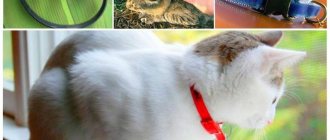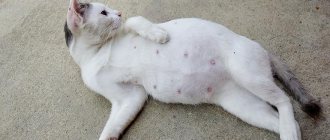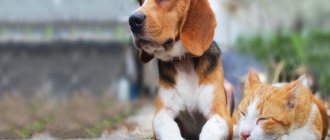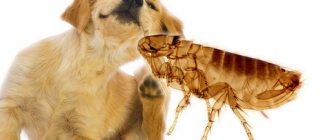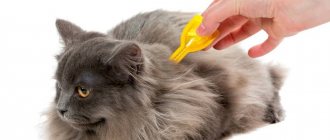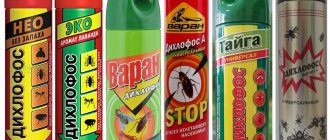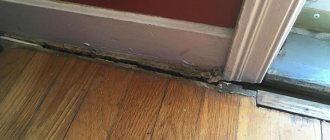Home » Cats » Rules for caring for cats » How to bathe a kitten? » How to wash a kitten with flea shampoo? How often and with what should I wash my kitten for fleas?
Bathing for kittens is a procedure that requires special care, since not all pets like to splash. The main reason is the wrong approach to this process: if the baby is not scared for the first time, then he will happily splash in the water.
Please note that before bathing, it is important to protect your pet’s eyes by putting special drops in them that will protect them from contact with detergents. It is better to protect your ears with a cotton swab.
Symptoms of flea infestation
Small blood-sucking insects look like black grains up to 2 mm long. They move by jumping, sucking blood from the animal, piercing the skin. It is enough for one flea to get on the fur of an animal, and the active process of its reproduction begins.
Kitten in the house
When fleas appear, the pet begins to behave restlessly, itches, and tries to get rid of the insects with its teeth. As a result, wounds form on the skin.
It is not difficult to find fleas on the body. When you part the fur, you can see black moving dots, droplets of dried blood, dark fecal grains and eggs that look like salt particles.
The largest concentrations of fleas gather in the tail area and on the lower back. When infected with fleas, a kitten will experience:
- itching;
- restless behavior;
- scratching the skin:
- swelling of the epidermis;
- dermatitis;
- hair loss;
- weight loss.
At what age can kittens be treated for fleas?
First you need to figure out what to do when fleas appear in newborn kittens. In this case, a small four-legged pet must be treated for fleas very carefully. Drugs should be selected taking into account the age of the pet so as not to cause harm to it.
At what age can kittens be wormed for the first time?
Flea infestation
Therefore, experts give a very categorical answer to the question of how to remove fleas from newborn kittens - it is not allowed to use antiparasitic agents for up to 1 month. The flea control procedure should be carried out as follows:
- wash or change the animal’s rug;
- vacuum the apartment thoroughly;
- comb out the fur.
Important! Once the kitten reaches 30 days, it will be possible to use anti-parasitic shampoos, use special drops, put on collars, and use special flea sprays.
Sanitation of the premises
After getting rid of fleas from your baby, you need to clean the room. You should thoroughly clean the carpets, sofas, armchairs and wash the kitten's rug.
Crevices in the floor and under the baseboard also require sanitary treatment, because they are an excellent breeding ground for insects, where flea egg clutches are stored.
The following steps must be completed:
- Thoroughly vacuum all fluffy surfaces and wash the floors with a damp cloth.
- Treat all cracks and spaces under the baseboards with insecticidal solutions or sprays.
- Wash and treat the litter using a special flea product for kittens.
- If there are other animals in the apartment, it is necessary to simultaneously treat their fur against fleas.
Another good way to protect your pet from biting insects is a mattress filled with fresh sawdust. Fleas do not like this smell and will not bother the baby. Bunches of fragrant herbs placed around the house will also help get rid of insects.
Instructions: how to apply flea drops
How to bathe a kitten: with what frequency and at what age
It is convenient to get rid of fleas using special drops. They are allowed to be used from 2 months of age. But if the kitten is still feeding on its mother’s natural milk, it is not allowed to remove fleas with drops. Why? Since a cat often licks her baby, poison can get into her milk. In this case, the kitten runs the risk of milk poisoning.
Instructions for use recommend dripping the product directly onto the skin, spreading the fur. The best area for treatment is the withers. The animal will not be able to reach this place to lick the anti-flea drug.
The number of drops for application is determined according to the instructions, taking into account the weight of the animal. Such preparations contain insecticides that are safe for four-legged animals.
Flea drops
But such drugs have a detrimental effect on blood-sucking insects and prevent subsequent infection. At the same time, experts recommend that to enhance the effect of the drug before and after treatment for 48 hours, do not bathe your pet.
Contraindications to bath procedures
But bathing procedures are not always beneficial for kittens. They have their contraindications:
- Age. You should not bathe a kitten until it is three months old. During infancy, the sebum glands actively develop. Bathing can cause a malfunction of the epidermis, and the kitten will be deprived of the amount of skin lubricant it needs. This is where skin problems begin: all kinds of dermatitis and other troubles. But this does not apply to kittens that were brought from the street.
- Graft. Even a person after vaccination is not recommended to wet the injection site. For kittens, the situation is more serious. The thing is that wet fur does not retain heat, and the cat begins to feel very cold. The kitten may even catch a cold. And vaccination and disease are incompatible things.
- Disease. Here the decision is made by the veterinarian. But if there is no strict need to bathe your pet at this very moment, then it is better not to do this.
I know that bathing kittens under three months is not recommended, but I had to do this several times with a month-old baby. My cat had a particularly restless specimen in her litter. They lived in the yard; the area to be surveyed was huge. But he was drawn exclusively to the dog’s enclosure. He did this early in the morning. At about 6-7 o'clock I found him already there, all wet and terribly dirty. The dog was glad to have company and took care of the baby, as her instincts told her - she licked it and carried it in her teeth on a tour of her property. The first time I found a kitten in this state, I was terribly scared. Having wiped it with a dry cloth, I quickly placed it under my mother’s side, hoping that she would clean it better than me. But it was not there. She sniffed it and moved away. An hour later he was already sitting in the corner of the box, no one wanted (luckily it was hot outside). I had to bathe him in running water. After this, the cat recognized her kitten and began to take care of him again. These attacks stopped only when the kitten’s head stopped getting through the mesh of the enclosure. By the way, the baby did not suffer from frequent bathing, but he grew up too clean - he licks himself for a long time and with pleasure.
How to use flea shampoo for kittens
At what age can a cat become pregnant for the first time?
From one month of age and older, experts recommend bathing kittens with anti-flea shampoo. The drug must be selected very carefully, since not all formulations are suitable for such babies.
The bathing procedure is carried out as follows:
- a small amount of shampoo is applied to the hand and diluted with water;
- the wool is actively lathered with a special solution;
- the soap solution is washed off;
- the wool is wiped and dried;
- The fur is carefully combed out with a comb.
Review of popular flea drops - application, indications and contraindications
To understand which flea drops to choose, it makes sense to analyze the best ones.
Inspector
This drug will help cure a kitten from fleas, ticks, and lice. The number of drops depends on the actual weight of the animal and is determined according to the table given in the instructions.
A contraindication for use is individual intolerance to the components of the drug.
Important! Kittens weighing less than 1 kg and under 7 months of age should not use the product.
Celandine
The drug is recommended for cats and kittens who are already 2 months old. Apply to dry skin at the withers and between the shoulder blades. One pipette with medicine is designed for a cat weighing 2-10 kg.
Drops Celandine
The drug should not be used in kittens under 8 weeks of age if they have an allergic reaction to its components or with a weakened immune system.
Advantage
With the help of these drops it will be possible to rid cats and kittens of lice, fleas and lice. The product should be applied to the withers, the dosage is determined by the weight of the pet. The result comes within 12 hours. The drug can be used to treat domestic kittens at any age. It is also allowed for pregnant and lactating cats. There are no contraindications.
Stronghold
Drops are prescribed to cats and kittens once from 6 weeks of age in the presence of fleas, ticks and helminths. The amount of product is calculated based on the weight of the animal, the effect occurs within 2 hours. Repeated use of the product will need to be done once a month.
Important! The product is non-toxic and has no contraindications.
Leopard
The drug is prescribed to remove fleas, lice and lice from the fur of a four-legged pet. It is used once in the form of drops, applied in the withers area, between the shoulder blades (in hard-to-reach places that cannot be licked off). The dosage depends on the weight of the animal and is determined according to the table located in the instructions.
Contraindications include intolerance to the components of the product, the presence of infectious diseases, age up to 8 months, weight up to 2 kg.
Beaphar
Drops are recommended for repelling fleas and other parasites, starting from 12 weeks of age in kittens. The product should be applied to the withers. The effect is observed for 1 month, after which the procedure will need to be repeated.
Important! Beafar should not be used by kittens with poor health and those pets that are in the recovery stage.
When not to use chemicals
The use of specialized preparations containing insecticides is permitted only for kittens that have already been weaned. This is due to the fact that the cat instinctively constantly licks its offspring, which leads to the ingestion of a toxic substance and subsequently severe poisoning and even death.
Until two weeks of age, no methods of handling a small animal, even bathing, are allowed. The baby has a weak immune system, so toxic exposure causes poisoning and death of the kitten.
What exactly is more effective: a collar or drops?
To understand the difference between flea drops and a flea collar, you need to understand that the drops are solutions for killing fleas. They may differ in chemical composition and degree of action. Another feature of droplets is the fact that parasites can adapt to some of their types. Therefore, they need to be changed after some time.
Collar
Important! Collars do not destroy parasites, but only repel them with their smell. Therefore, to achieve the greatest effect in the fight against parasites, it is best to combine two methods. First, you will need to treat the pet's fur with drops, and then put on a collar for preventive purposes.
The advisability of bathing
First of all, this is an opportunity to get rid of insects that parasitize a small pet. The active substances that make up industrial sprays, tablets and gels are quite aggressive. The baby’s immunity is just beginning to develop and any poisoning caused by toxic drugs can be fatal.
Bathing a kitten with flea shampoo is the only panacea for blood-sucking parasites. Therapeutic water procedures are especially important for purebred cats, for example, Scottish or British, because they have a very difficult time being around these insects.
For reference! Some cat breeds love to swim and enjoy spending time in the water. Among them are Maine Coons, Bobtails, Egyptian Mau and Bengal cats.
Folk remedies that remove fleas from baby cats
Among the folk methods of effectively combating annoying fleas are:
- sagebrush. You can use a decoction of plants to wash the fur of kittens or lay out branches of the plant on the floor of the apartment;
- combing with a thick comb (but in this way it will not be possible to completely rid the animal of parasites);
- pine sawdust. The blocks do not tolerate the smell of pine, so sawdust can be placed under the animal’s rug and spread on the floor in the apartment;
- a mixture of soda and salt. Sprinkle the powder on the carpets in the apartment, and after 4 hours vacuum them;
- tar soap. Lather the fur of a 2-month-old kitten for 5 minutes, then rinse with warm water.
How to bathe at 2 months or more?
At the age of 2 months, it is better to wash the kitten without using shampoo using regular warm water. From 3-4 months you can start bathing with a special shampoo, which will determine the pet’s entire future attitude towards this procedure.
It is important to remember that kittens also have allergies and intolerances, so it is worth monitoring their condition after washing. If your pet shows signs of illness, you should immediately visit a veterinary clinic or listen to the doctor’s recommendations over the phone.
How to properly wash a kitten without causing him stress
Cats are afraid of water.
Bathing a kitten
To avoid causing your animal stress from bathing, you should adhere to the following rules:
- accustom him to water gradually, starting with wiping his paws. You cannot put a cat in the bath while water is pouring in. The sound of water will cause shock. Do not use brushes or sponges while bathing. Only light touching and stroking with hands is possible;
- When washing with shampoo, do not allow the soap solution to get into your eyes. Therefore, it is better not to wet the kitten’s head;
- the remnants of the shampoo should be washed off well so that the animal does not get poisoned after licking the water;
- Upon completion of bathing, the kitten should be wrapped in a terry towel and taken into the room.
Prevention
Even animals that don't go outside can become infected with fleas. To protect your pets, the following conditions must be observed:
- maintain cleanliness where the pet lives;
- periodically inspect the animal for the presence of insects;
- apply antiparasitic agents;
- do not allow your four-legged friend to interact with homeless animals.
Summarizing all that has been said above, we can draw a simple conclusion: it is not difficult to remove fleas, but it is better to prevent their appearance. Therefore, the pet owner must carefully monitor the cat, as well as kittens, and do everything possible to prevent blood-sucking insects from darkening their lives.
Video
